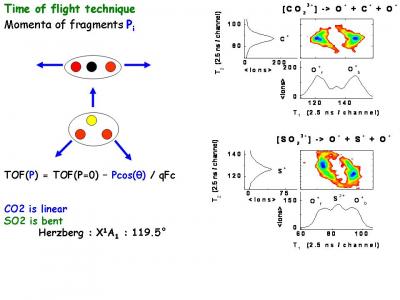
Coulomb explosion of CO2 and SO2 at 40 fs. The correlation between the oxygen ions and the carbon ion for CO2 and the sulphur ion for SO2 gives the geometry of the initial system. Notice the elliptical correlation shape for the bent SO2. The spatial resolution remains poor due to the internuclear stretching during multiple ionization
In the 1990s, Coulomb explosion of small molecules has been extensively studied using pulses durations of a few tens of femtoseconds. The stretching of the internuclear separation R was observed during multiple ionization and lead to the important concept of Charge Resonance Enhanced Ionization discovered by A. Bandrauk et al. We have shown that the excitation of N2 or CO2 with 10-fs pulses inhibits any significant stretching. In addition, the fragmentation yields are lower in few-cycle pulses because of the 1/R scaling of the molecular multi-ionization thresholds. These results open the way to femtosecond time-resolved Coulomb explosion imaging of molecules using few-cycle laser pulses.

Kinetic energy release of the N2+ + N2+ fragmentation channel of N2 following the emission of 4 electrons from the molecule recorded with pulse durations of 10 fs and 40 fs. The increase of the energy as a function of the laser intensity is a pulse rise time effect. The energies near the Coulomb limit allow one to infer the neutral molecule geometry.
L. Quaglia and C. Cornaggia, Phys. Rev. Lett. 84, 4565 (2000)
C. Cornaggia, Molecules and Clusters in Intense Laser Fields, Chapter 3, Cambridge University Press (2001)
E. Baldit, S. Saugout, and C. Cornaggia, Phys. Rev. A 71, 021403 (2005)


